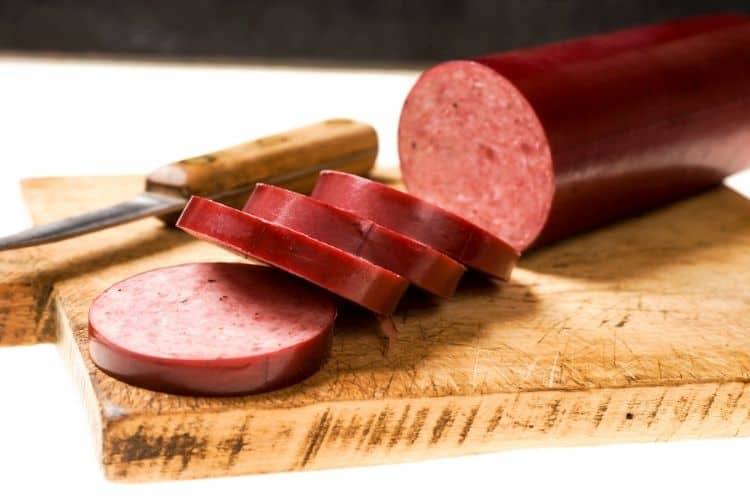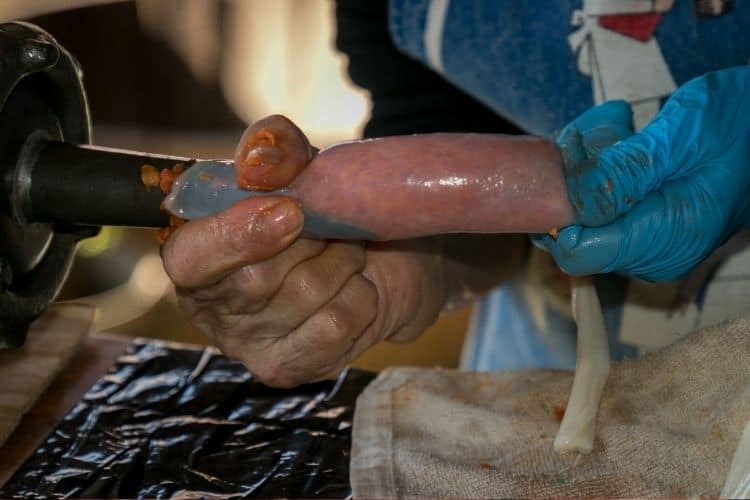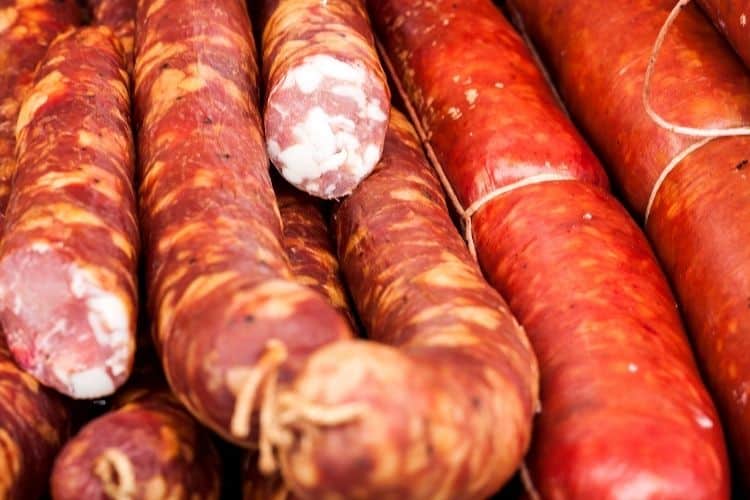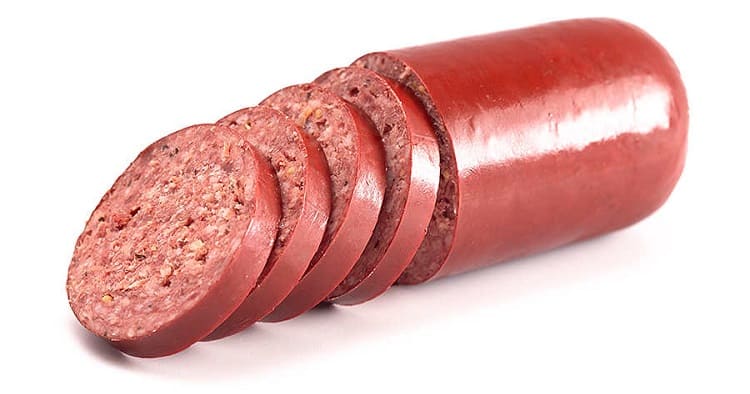- Best Summer Sausage Casings Guide - October 4, 2021
- Chef’s Choice Knife Sharpener Review and Guide - September 3, 2021
- How to Find the Best Meat Tenderizer Tool - September 1, 2021
As one of the most popular kinds of food, you can find a large variety of sausages around the world. Whether you’re in America, Europe, South America, or even East Asia, you’re sure to find people eating some type of sausage. But despite its popularity, a good sausage can sometimes be hard to come by.
When making a sausage, you will want to be certain it’s being made with the right ingredients including finely ground meat, the right balance of spices, and most of all, the perfect casing. In this article, you’ll be reading more specifically about Summer Sausages and how to find the right casing for them.
Read on to Find Out About
- What makes a sausage a Summer Sausage
- What to look for in a good casing
- Which casings are the best for a Summer Sausage
- And more
What is a Summer Sausage?

To put it simply, a summer sausage is any type of large, semi-dried sausage that can stay well preserved outside of the refrigerator. It is often larger in shape and dryer than a regular sausage. During preparation it is fermented, cured, and either dried or smoked. For ingredients, it is often made using a mixture of pork and beef and a mixture of spices to give it a distinct flavor.
It is also eaten differently compared to a regular sausage. Whereas most sausages you buy raw and then grill, bake, or pan fry before eating, summer sausage is already ready to eat when you buy it. In addition, most sausages are often prepared for a meal while summer sausage is eaten as a snack. Often times it is paired with cheese and crackers. You can also use it as part of a sandwich.
How to Prepare Summer Sausage
Preparing a summer sausage is also in some ways similar to other sausages and in some ways different. There are several steps you have to take when preparing the sausage.
Step 1: Getting the Right Meat
While a balanced mixture of beef and pork is used most often, some cooks might prefer to use all beef or all pork. You can also use a variety of mixture of the beef and pork such as three quarters pork to one quarter beef or the reverse. It ultimately comes down to your preference.
Step 2: Ground the Meat
Once you know you’ve obtained good quality meat, the first thing to do is grind it down using a grinding machine. If you have one at home then you can use your own machine. If you don’t have one, most butchers shops should be able to do it for you.
Step 3: Mixing Your Spices
As with any sausage, you’ll want to make sure you spice it properly to your liking. Some of the spices that are most commonly used in summer sausage include pepper, garlic, mustard seed, and salt. You can add more beyond these of course but use these as a base. Also, if you have a mortar and pestle or some other grinding tool, grind down your spice mix together so it can more easily blend into the meat.
Step 4: Mix the Meat and Spices
This is perhaps the simplest step. Here you simply need to make sure your meat and spices are mixed well enough so that the former permeate all throughout the latter. You can simply use your hands or a mixing tool if you prefer.
Step 5: Stuff the Meat Into Their Casing

While stuffing the casings with your hands is certainly possible, it can be a very messy and frustrating process. Most experts agree you should buy a ready made sausage stuffing tool instead. Many are available online for fairly cheap prices and are easy to use.
Step 6: Fermenting the Sausage
In order to ferment the sausage, you need to cover it with salt. This will dry out the sausage and also prevent it from spoiling. In addition, it also lowers the acidic content. Once the sausage is covered with salt, put a tight lid on the container it’s in and store it in a warm, humid place for at least 24 hours.
Step 7: Cooking the Sausage
The next step is actually smoking the sausage. Ideally, you should keep your smoker under 200 degrees Fahrenheit in order to give plenty of time to absorb the smoky flavors of the wood chips. The entire smoking process will take up to several hours or more. Alternatively, you can also bake your sausage in the oven instead.
Step 8: Storing the Sausage
Once your sausage is fully prepared, all you have to do is find a good place to store it. You will need to find a relatively cool place but not necessarily a fridge. If you have a cool section of your basement to use, that may work well. Now that your summer sausage is all done, you can enjoy eating it whenever you want. Often times they are perfect to use as an appetizer at parties.
Sausage Casings

Casings are in some ways the most integral part of the sausage making process. They are what holds the meat together and keeps it from falling apart. Without it a sausage would really just be a bunch of ground meat.
Traditionally, sausage casings have been made out of the entrails of an animal. More specifically, it would come from the intestines of a pig, a sheep, or a cow. Of course, these intestines are cleaned thoroughly before being used for sausage making.
While many sausage casings these days are still made from animal intestines, most use a specific layer of them called the submucosa rather than the entirety of the intestinal tissue.
In addition to traditional casings, you can also try looking into synthetic casings. The most popular of these is made of collagen, a compound found in the cellular anatomy of all living animals, and is extracted from animals to make the casings as well.
Some sausage makers may prefer collagen to natural casings. There are also casings made from cellulose and plastics though these are most of the time inedible and must be peeled off before eating.
Some sausage makers may also prefer to use no casing at all. In order to do this you need to pack the meat very firmly and add bread crumbs or something else to hold the meat together. Though this method can work, it is generally not recommended as the meat can still break apart while cooking.
What Makes the Best Sausage Casing?
There are several things to think about when weighing your options for which sausage casing you want to buy.
First, you should consider your budget. As with anything you purchase, you will want to remember if the type of casing you purchase and how much you need reflects your monetary situation and how many sausages you want to make.
Most often sausage casings come in packs and can generally sell for anywhere between 10 and 40 American dollars. Both natural and synthetic casings can cost roughly the same.
The next thing you should think about is how skilled you are with actually stuffing the sausage into its casing. Improperly stuffed sausage can lead to negative effects such as air pockets that can break open causing the meat inside to spill loose. Many experts agree that a casing made from hog intestine is a good choice for beginners since they are considered to be the easiest to work with.
What is perhaps most important when it comes to the actual quality of the sausage itself however, is how tough the casing is. Naturally, you do want to make sure your casing is tough enough to hold all the meat inside.
But at the same time, you will want to make sure it is soft enough to chew through and break down easily. In order to properly assess the quality of the sausage casings you want to buy, make sure to find and read reviews from previous buyers.
The Best Casings For Summer Sausage

Most sausage makers prefer to use a couple different synthetic casings when they make their summer sausage. These two casings are of the fibrous and collagen type.
The first thing you should know about fibrous casings is that they are not edible. They are made from tree cellulose and are supposed to be only used during the cooking of the sausage. After it’s done cooking you peel it off. It is often very flexible and tough which makes it perfect for cooking dried sausages such as summer sausage.
You also need to make sure to soak the casing in warm water for at least 30 minutes before stuffing it with the sausage meat so as to loosen it and make it easy to work with.
The other type of casing commonly used with summer sausage, collagen, differs from fibrous casings in several respects. For one, it is made from natural animal protein and is usually extracted from cows or pigs. Therefore, it is in some ways more related to natural casings than other synthetic ones. In addition to its genetic makeup another difference is that it does not have to be soaked before use.
Perhaps most importantly, however, collagen casings are edible. This of course means that you can smoke the meat in the casing without having to peel it off before you eat.
There are a variety of sausage casings you can try working with. If you’re a more experienced sausage maker you may be able to work with other sausage casings.
However, it is generally advised to use either of the two above types of casing, especially if you’re a beginner. Ultimately, which sausage casing you choose to use is up to you but know that not all sausage casings naturally pair with summer sausage.
FAQs
Question: What is the Difference Between Summer Sausage and Salami?
Answer: Salami, like summer sausage, is also considered to be a dry sausage. That is, they are both cured and preserved rather than eaten directly after cooking. They both lose a certain percentage of their moisture content during this process. But the main difference is that summer sausage loses only 15% of its moisture content while salami loses 25% of it.
Question: Can I Leave My Summer Sausage Out in Room Temperature?
Answer: While you may not need to store your summer sausage in the refrigerator, it is also ill advised to keep it in an area that’s at room temperature or higher. Though it may stay okay longer than some other foods, keeping it at this temperature will still shorten the time it takes for the sausage to spoil.
Question: Is it Okay to Freeze Summer Sausage?
Answer: Yes, summer sausage is safe to freeze. In general, it can last around ten months being stored in the freezer. It may last longer than that before it spoils but it will probably be of lesser quality.
Question: Is Summer Sausage Healthy?
Answer: Summer sausage is high in sodium and also in fats. However, it is also low in calories and high in protein. As with many foods, you shouldn’t overeat them but consider your own health and diet if you are wondering whether snacking on summer sausage is okay for you.
Conclusion
A summer sausage is always a great choice for those wanting to make a great party appetizer or just for something to snack on during those hot summer days. While distinctly different from most sausages, a summer sausage offers a unique taste and texture that is hard to replicate with other recipes.
Making a summer sausage is however in many ways similar to making a regular dinner sausage but with a few extra steps. Rather than being grilled or baked, it is instead smoked and preserved in order to last a long time without any need for refrigeration.
When it comes to casings there is a large variety to choose from but only a few really work with summer sausage. In particular, collagen and fibrous casings are said to work best.
Overall, summer sausage can be very easy to make if you know what you’re doing. Just make sure you have the right casing and other ingredients and in the end you’ll have a delicious snack you will enjoy.
Further Read:
Best Sausage Stuffer Guide: Which Is Worth Your Money?

